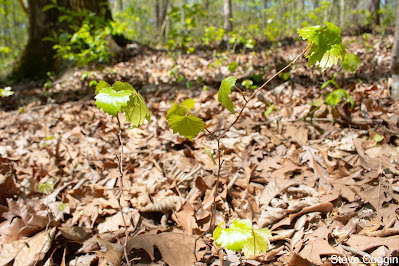 |
| Muscadine Grape (Vitis rotundifolia). Lincoln County, North Carolina. |
Vines are trailing or climbing plants with long stems. Vines with woody stems are technically called lianas while those with herbaceous stems are just vines. One of the world’s best-known vine (liana) is Grape (Vitis sp.).
 |
| Vineyards of Common Grapes (Vitis venifera). Collioure, France. |
People domesticated grapes (Vitis vinifera) about
8000 years ago in the Middle East. The
versatile fruit of this vine can be eaten raw, dried into raisins and, of
course, fermented into wine. The
earliest known wine production was in the mountains of Iran about 5000 years
ago and the drink has been going strong ever since.
 |
| Fox Grape vines with flowers (Vitis labrusca). Rowan County, North Carolina. |
 |
| Fox Grape fruits. Rowan County, North Carolina. |
Grapes are classified in the family Vitaceae and there about 8 native species in the Southeastern United States. Grapes are borne on woody, deciduous vines. Grapevines flower in spring, making green, wind- pollinated flowers. These develop into bunches of juicy, dark purple berries by late summer. These fruits are feasted upon by many mammals and birds. Grape seeds pass through the digestive tract of these animals unharmed and are deposited some distance from the parent vine to establish new plants.
 |
| Young vines of Muscadine Grape growing on the forest floor. Rowan County, North Carolina. |
 |
| Muscadine Grape Vine rambling. Rowan County, North Carolina. |
Grape seeds require full sun to germinate, then the young vines grow across the ground seeking vertical support. Grapevines scramble onto other plants and use tendrils to attach to branches. Grapes need bright sun to thrive, so they live at forest edges although some vines are found deep in the woods.
 |
| Young Muscadine Grape tendril. Clayton County, Georgia. |
 |
| Vitis sp. growing into the forest canopy. Rowan County, North Carolina. |
 |
| Porcelain Berry (Ampelopsis glandulosa) is an invasive relative of grape. Mecklenburg County, North Carolina. |
Porcelain Berry (Ampelopsis glandulosa) is an invasive member of the Vitaceae that is found throughout Eastern North America. This native of East Asia is also a woody vine and it produces grape-like berries. Porcelain Berry vines can have purple, blue, green and porcelain white berries all in the same cluster. Like grapes, the Porcelain Berries are distributed by birds and other animals. It has become a serious pest in some areas, shading out native shrubs and small trees.
 |
| Porcelain Berry vines and fruits growing in a tree canopy. Guilford County, North Carolina. Drone photo courtesy of Dr. Joe Poston |
Grapes and humans have a long history. The vine was taken under domestication early in the agricultural revolution and has traveled around the world with people. Grapes contribute hundreds of billions of dollars to the United States economy each year and wine is produced in every American state. Before modern sanitation, is was often safer to drink wine than water. In addition to the protection from water-borne diseases, wine also contains alcohol, a mind-altering substance. These two important features of wine probably led to its place of importance in many world religions. Beyond the economic and cultural impacts of grapes, they are keystone species in natural ecosystems. I will continue to explore other vines in upcoming editions of this blog. Thanks to Dr. Jay Bolin for his generous help with grape identification.
 |
| Muscadine vine with woody tendril. Rowan County, North Carolina. |
No comments:
Post a Comment